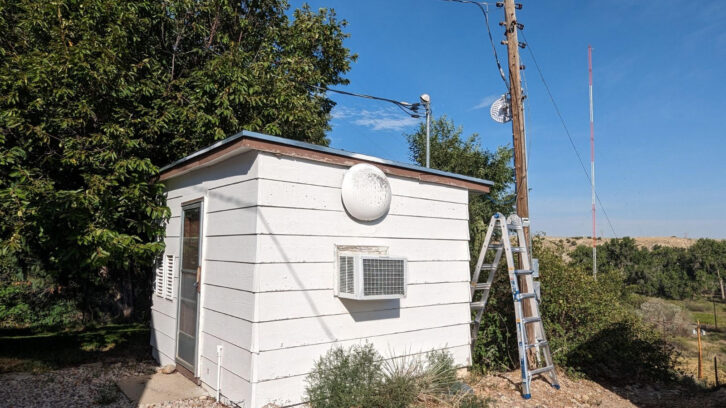Working with small stations and groups, an engineer may take on certain tasks beyond the expectations faced by someone at a larger company with more resources.
To paraphrase the classic police drama, the story you’re about to hear is true. The names have been changed to protect … well, everyone.
In early 2021 I was contacted by the manager of a small group seeking help with a project. It involved an AM transmitter building that is near my home but 600 miles from the company’s headquarters.
Years ago this station’s studio and transmitter had been installed in a house on a bluff, while the antenna was placed along a river bottom directly below.
The house was later sold off though, and now the transmitter “building” was a small shed in the backyard while its AM tower and FM translator antenna remained below.
The company wanted to install a new transmitter building in the river bottom right next to the tower, near the tuning house and atop a three-foot pedestal to stay clear of occasional floods.
They asked if I would manage this project. Being semi-retired, I responded that I would be happy to assist but that I did not want to manage the entire process. The company hired an engineer who lives about 200 miles away but who has more experience in such projects.
Underpowered
The AM station is licensed for 3200 watts but was operating with an aged Harris SX series transmitter running at much lower power. Everyone was anxious to get the project done.
The river bottom presented access challenges for the concrete mixer trucks, but eventually the base for the building could be poured. Covid issues and other delays caused work to stretch into 2022, but a contractor eventually completed the building and an electrician put in the necessary elements to make sure the installation was up to code for an outbuilding with extra power for HVAC and a new transmitter.
A Nautel transmitter had been ordered and was on the way. The necessary interconnects for the tower were ready to go. We’d be on the air very soon, right? Sadly, not so.

Missing paperwork
In June 2022, the building was ready for electrical inspection so the local provider could proceed to hook up power service. It was time to contact the regional building authority.
But the engineer managing the project from 200 miles away wasn’t getting responses to his email inquiries to the authority. One of the authority’s employees had been a student when I taught National Electrical Code at the local community college, so I volunteered to talk with them in person.
When I arrived and explained the situation, they asked for the address of the building. It had no recorded address, which was the first problem, though a minor one.
But the second problem was that this was considered a new commercial building. This county requires that before construction on such buildings can begin, a licensed mechanical engineer must submit plans for approval.
Later I learned that the electrician had pulled a permit for modification of existing structures. When the electrical inspector came out and saw that this was new commercial construction, he did not pass it.
The authority also wanted to know who the contractor and electrician were so they could issue them a warning. And they advised me that a local electrical provider must not hook up power to the building until plans were approved and inspections completed. Only then could we get power and move on.
So much for timelines.
[Check Out More of Radio World’s Tech Tips]

A few weeks later, the transmitter was delivered via semi to a parking lot nearby. We laid it in the back of my pickup truck, crept down to the building in the river bottom, and rolled it into the building on some pipes. We uncrated it and set it upright in place.
Such a nice site … the air conditioners all ready to go and all the materials in the building … so close and yet so far.
We had all the pieces in front of us now. But lacking a permit for new commercial construction — which depended on plans from a mechanical engineer — and without an approved electrical inspection — which was still not yet completed — we could not proceed.
Ultimately, each of those steps were completed. We made the necessary minor upgrades to the building, and our electrical engineer upgraded the Romex and plastic boxes to armored cable and metal boxes.
Only now could the company submit the necessary paperwork to the regional building authority, which proceeded with the necessary inspections. Approvals were granted with few further considerations, helped by the fact that the antenna had been in that location since the 1950s.
A final hurdle: Because the antenna was in a floodplain, FEMA personnel had to be involved, but once they realized the building was on a three-foot pedestal, they granted approval.
Lessons learned
At last the new AM transmitter could be turned on. The station and its FM translator were in service from the river bottom. But it had taken an extra 14 months to complete the installation, from the time we learned of the licensing omissions. And the costs had far exceeded what the licensee had anticipated.
What lessons can be learned? Whether you are the licensee or an engineer working on a project:
- Visit the local authorities yourself and ask a lot of questions before putting up any building, even if it is a small structure that is inaccessible to the public in a river bottom.
- Be sure to understand what is required to be done by mechanical and electrical engineers, identify them and what those costs are going to be.
- Do not assume that local contractors will know or follow the regulatory requirements for a project. Know them yourself.
- Smart project management and better communication could have saved time and cost in this case. Make and update detailed lists of tasks — and who is assigned to complete them.
- Do a daily follow-up with anyone involved in these tasks. This will keep the project timelines as tight as possible.
Who was responsible for the problems we encountered? In some ways we all were. The big lesson is the same as always: Someone needs to have a little sign on their desk that says “The Buck Stops Here.” And that person needs to have the authority to do what it takes to move a project forward.
The slogan still holds: “Failing to plan is planning to fail.” It is almost impossible to spend too much time or having too much detail before starting a project.







